I manage this blog, a newsletter, and I’m also working on an upcoming podcast, all while working full-time as an engineer.
Want to know how I get so much done?
In this post, I’ll be talking about the process I follow to keep myself productive, and get things done, every single day.
So, let’s start with:
How I divide my day into time blocks
Right now, managing this blog is a part-time job for me.
Probably in the future, I can work full-time on Hulry, but right now, I have to keep my day job to pay the bills.
To keep things separated between office work and working on Hulry, I’ve divided my days into three distinct blocks:
- Pre-office (8 AM → 9:30 AM): Work on the Hulry project. For example, right now, it’s 8:25 AM, and I’m writing this blog post.
- Office time (10 AM → 6 PM): Office work. I dedicate the lion’s share of my time to working on my full-time job. This time range works best for me, as I can be in the office at a reasonable hour, and wrap up before I get too exhausted.
- Post-office (7 PM → 8:30 PM): This is the time I get back to working on Hulry.
Although I wake up at 6 AM every day, I take my time to ease into the day by freshening up, listening to podcasts, and having some tea.
So, 8 AM is more or less the time when I start work.
Keeping clear boundaries between work and personal projects is essential.
Not only does it help in keeping focused on a specific area, but it also keeps me protected legally.
Here’s another tip for legal protection in employment:
Apart from drawing a time boundary, I also use two laptops throughout the day — one for personal projects, one for office work.
Although the Hulry project is not competitive in any way with my office work, I keep things separated to honour my employment contract.
For the same reason:
If you’re not working on your own business full-time, I would highly recommend you keep your day job separated from your side hustle.
With time blocks set, let’s move on to:
The most useful productivity tip, ever
Plan your day, the night earlier.
Apart from all the other productivity tips out in the wild, this one has worked wonders for me in getting stuff done.
Planning my day the night earlier helps me save decision time in the morning, and focus on the task at hand.
Also, having to decide what to do for the day ahead is a procrastination wormhole.
You start with planning what to do, and the next thing you know, you’re browsing social media.
I avoid that hiccup by planning my tasks early, like this:
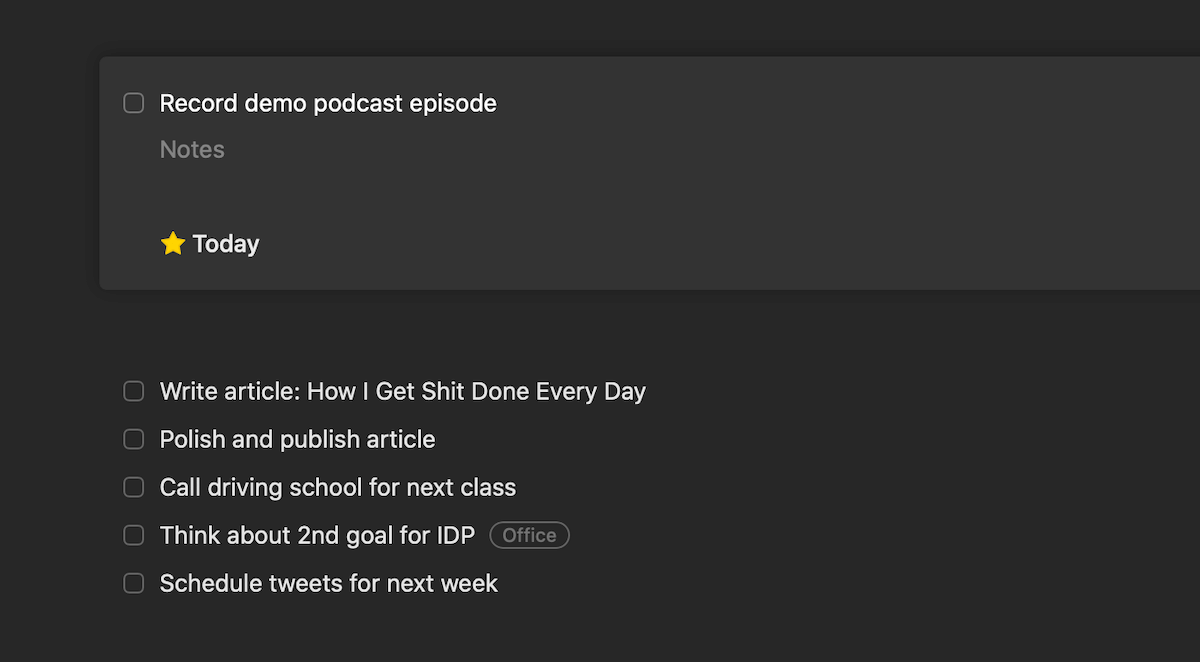
I spend around 10–15 minutes every night before going to bed to plan out what I need to do the following day.
Any overdue tasks get carried forward as well if I think I can spend some time on them.
Once added, I schedule my tasks for the next day, like this:
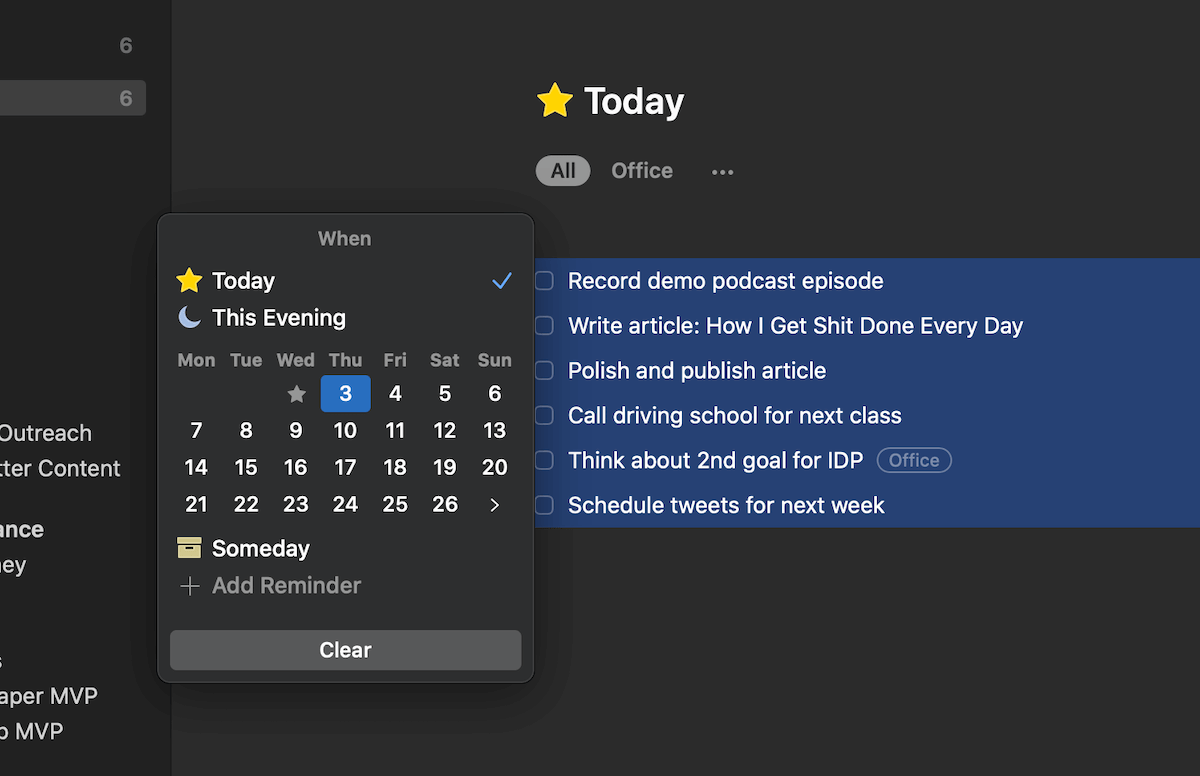
One thing to note here though:
As I mentioned earlier, I divide my day into personal and office work time blocks.
To distinguish office work from personal, I add an “Office” tag to all of my office-related tasks.
This technique allows me to filter out tasks based on the tag, and focus only on the tasks that I need to do during a specific time block.
For example, in the morning, I would filter the view to show tasks which are not tagged.
This way, I only see tasks related to personal projects in the morning pre-office slot.
Neat trick, right?
Apart from this, another little organisation trick I use is to:
Split tasks between morning and evening
I work on personal projects both before and after office hours.
Deciding what to do in the morning, and what to check off in the evening gives me a focused to-do list.
Things 3 has an excellent way of grouping tasks in the day and tasks for the evening, like this:
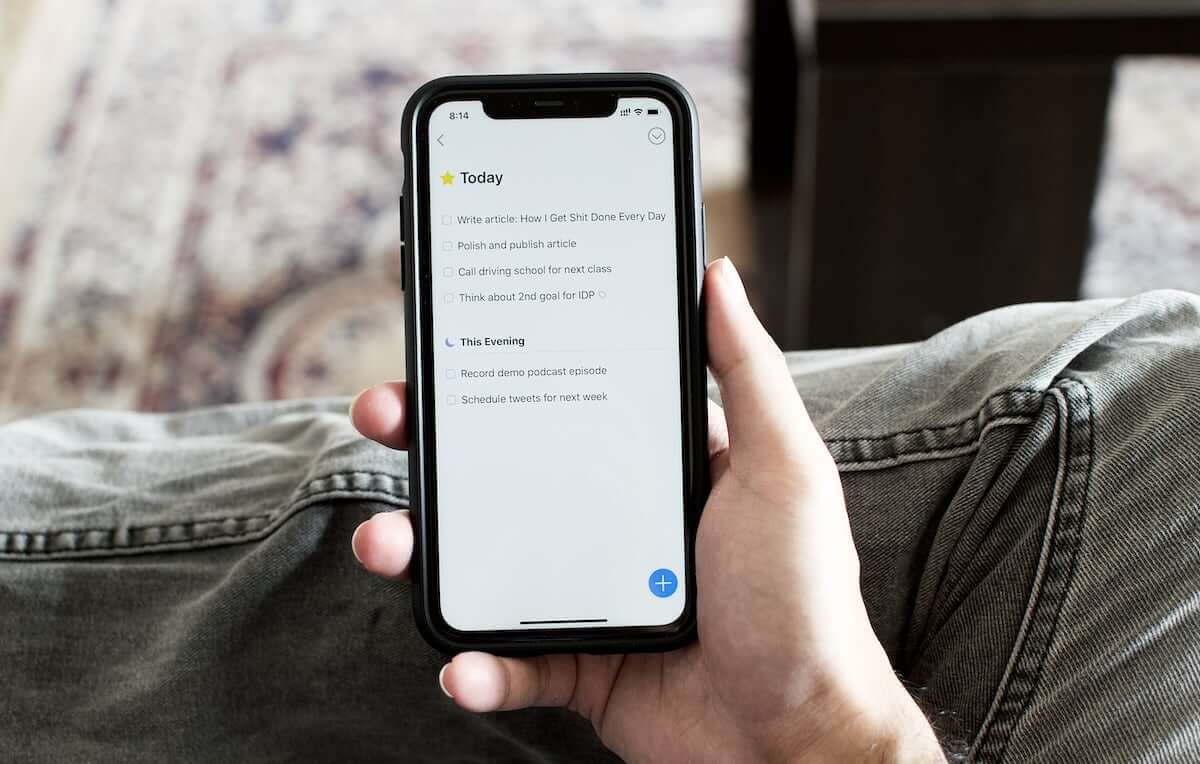
I love this little visual distinction.
Before starting on any task in the morning, I pick out some tasks that I would like to do in the evening, and reschedule them like this:
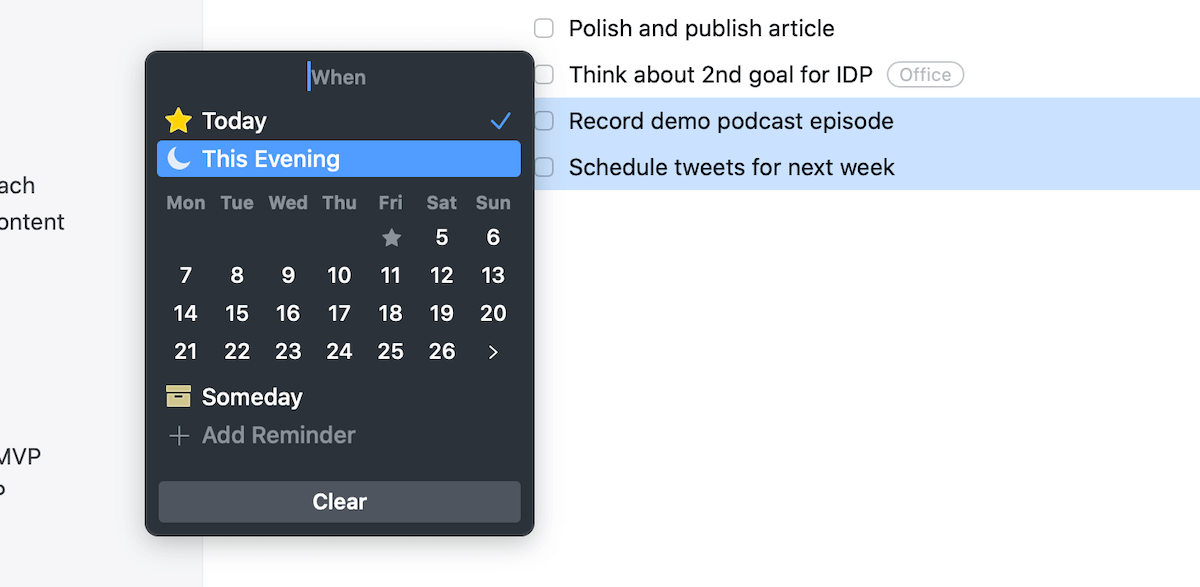
If you’re not using Things 3, you can create your version of this view with the help of task priority, or by tagging your tasks.
Here’s what my to-do list would’ve looked like in Todoist:
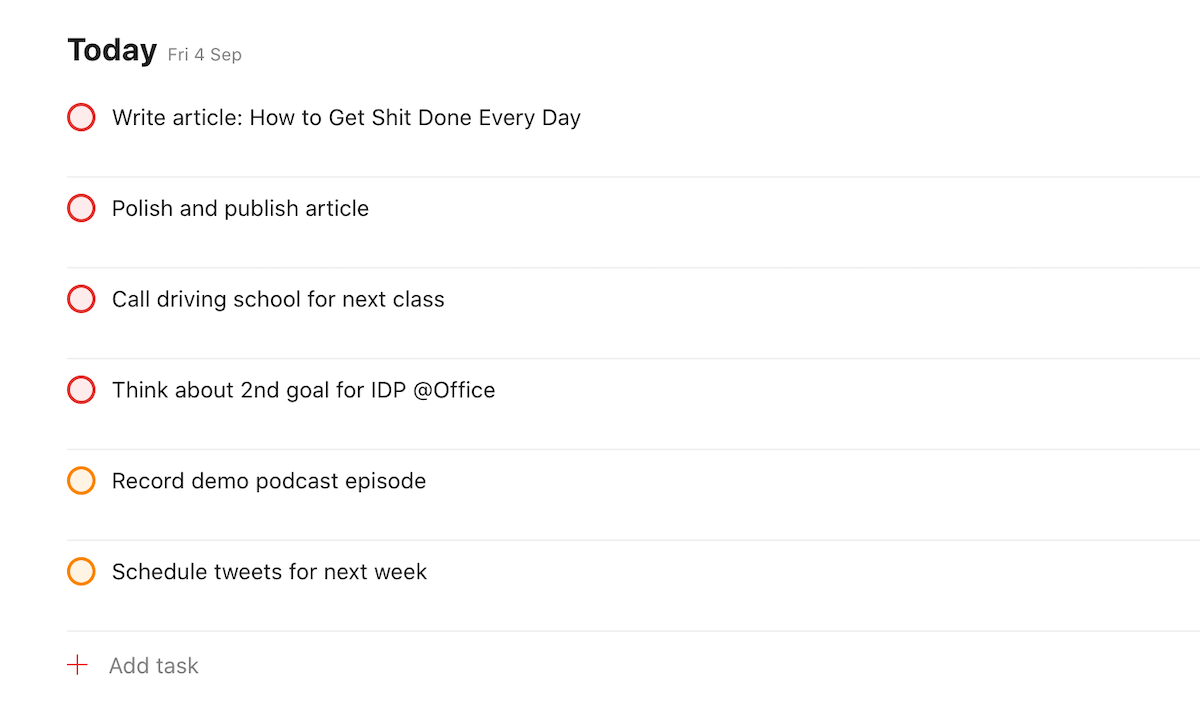
Although this is not the same visual distinction as in Things 3, Todoist colour codes my tasks based on the priority set.
The colour coding provides a nice break between tasks in the list.
With task planning done, every day, I pick tasks from my to-do list for the day and get them done.
That’s the flow.
Now:
There are times when I want to note down a task but might not get to it the next day.
The approach I described until now, works only for tasks I need to do the next day.
When I need to jot down a task without a known schedule, I follow the process of:
Adding tasks to a backlog
Your mind might immediately think of a Kanban board on hearing backlogs. However, I’m not going to be talking about sprint planning here.
What I do is, add whatever task or idea that comes to my mind, to an Inbox on my to-do list app.
You can use Trello, or Todoist, or whatever tool you’re comfortable with building a backlog. I use Things 3.
A quick note:
I had tried a technique in the past where I built a backlog on a Kanban board app like Trello or Jira and then ported over tasks for the day to my to-do app.
While it worked for some time, I felt I was doing too much work to manage tasks.
Now, I only use Things 3 for my entire process of task planning.
This is what my Things 3 inbox looks like:
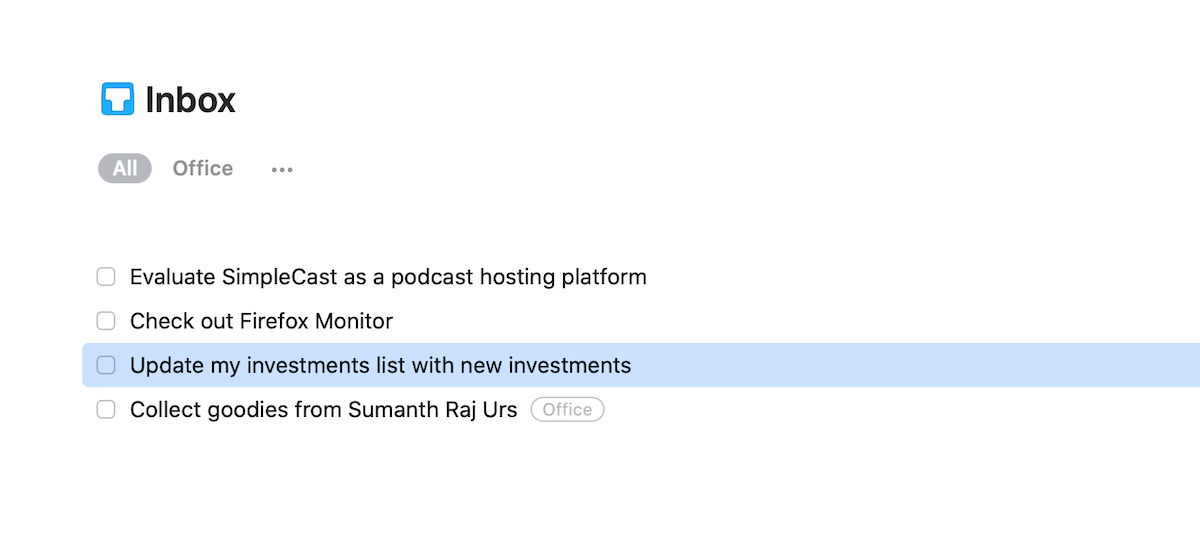
You might be shocked to see just a few tasks over here. That is because I don’t keep tasks on my inbox for a long time.
Now, this doesn’t mean I tick off items like a robot.
I usually:
Organise tasks from my inbox to specific projects
I take some time every 2–3 days to move tasks from my inbox, into specific projects.
This system helps me locate tasks very quickly, and also keep an eye of how much progress I’ve made on a specific project.
Here are some of my projects in Things 3:
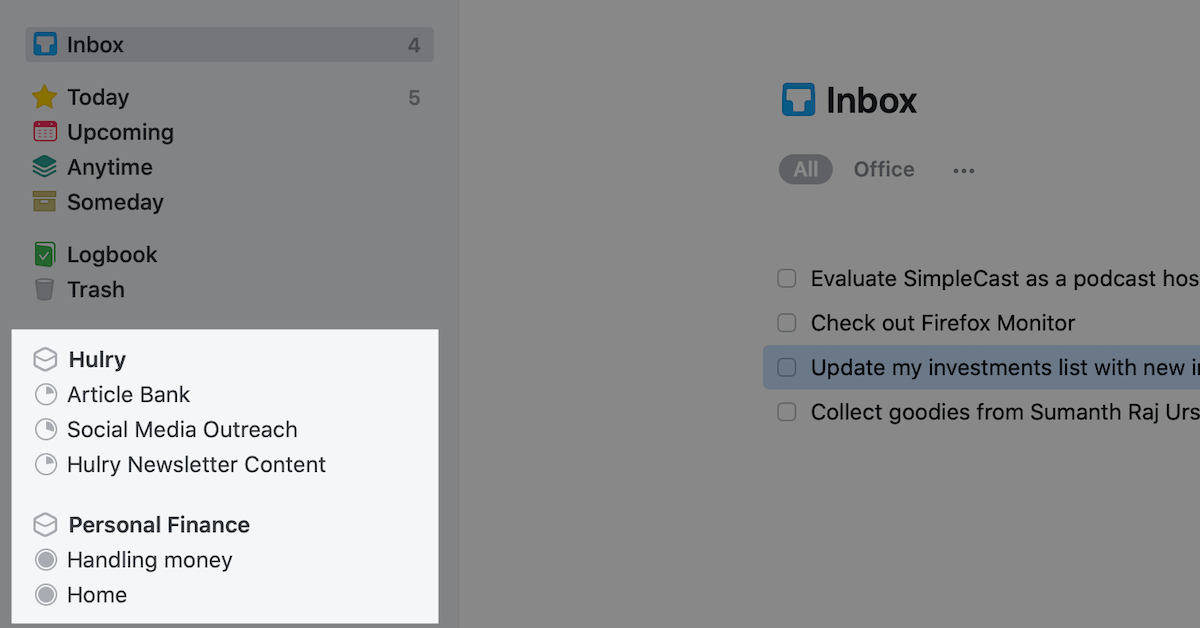
You can see that I have broken down the Hulry project into multiple sub-projects.
This approach helps me in having focused and achievable projects which don’t aim to do too many things.
While picking out tasks for the next day, I also check tasks which I had already added to my inbox or a project.
This process ensures my projects are progressing, instead of being a graveyard of things to do.
Notice the smooth pipeline forming here:
Inbox → Project → To-do for the day → Done
Task planning is one part of getting things done; the other part is execution.
To ensure buttery execution, I:
Take adequate breaks while working
I don’t follow the Pomodoro technique, but I do take strategic breaks.
What I mean by strategic breaks is that I take a break either when I finish a part of my work, or when I feel like I need one.
I don’t usually take long breaks, but frequent shorter ones.
This strategy keeps me going for a long time without feeling too burned out.
For example:
It’s 7:37 PM now, and I’m finishing up writing this post because I didn’t get to finish it during my pre-office time.
I just came back from a break, watching Shark Tank with my wife for about 20 mins.
Now, I’m ready to work again.
Also, I don’t try to “utilise” my breaks by reading a book or listening to a podcast during my break time.
I do whatever I feel like doing at the moment. Like listening to songs, or probably watch a YouTube video.
Anything that I feel will help my mind disconnect from work and recharge a little bit.
Pushing another task during the break time never worked out for me.
Instead, I had more anxiety and got less stuff done.
So remember:
Breaks are important. Take them.
Apart from this, another thing I do for smooth operation is to:
Block out distractions from my surroundings
Distractions creep in easily.
One moment I’m writing, and the next I’m on Twitter mindlessly scrolling through my feed.
I have tried distraction blocking apps like Freedom and Self Control in the past, but those apps make me feel jailed.
What works best for me is having the discipline to not give in to distractions.
For example:
I’m focused on writing this post right now. Not checking my email or Twitter.
Once I finish writing, I can take some time to get back to those areas.
Building discipline is not easy.
However, here are some things that helped me get to where I am right now:
- Silence and put your phone upside down. This helps in not getting distracted every time my phone receives a notification.
- Be mindful. Suppose I find myself on social media in the middle of doing something important. In that case, I recognise that and get back to my work.
- Listen to music. This is one of the best ways to get into the flow. Having earphones on gives me a sense of isolation from the surroundings. However, I try playing songs which I’ve already listened to over and over again. New songs attract more attention and thus instead make me distracted.
Okay, so:
The whole process might look like a lot of work, but it’s not.
Once you repeat this process for about a week, daily, it becomes easy.
However, here’s an important point to remember:
Don’t be too hard on yourself if you don’t see the level of performance you’re expecting, right out of the gate.
Have faith in the system, and keep going.
To make it easier for you to get started, here’s how you can follow my technique to:
Get stuff done easily
You don’t need Things 3 to apply my process. You can use another to-do app, or just a pen and some paper, if you’re more comfortable with that.
Every night, before going to bed:
- Make a list of tasks you need to do for the next day. These can either be tasks on top of your head or tasks you have already added in your backlog.
- Schedule your tasks throughout the day, according to your comfortable schedule. For me, I schedule personal tasks during my pre and post-office times and office work in between the other two blocks. You can figure out a similar schedule if your current job situation is like mine.
- Block out distractions, and get to work.
- Take a break every 30 mins, or whenever you reach a milestone. Don’t work on something else during the break; enjoy it.
- Repeat.
With this process, I’m sure you can be productive every day.



 In-depth articles, series and guides
In-depth articles, series and guides
